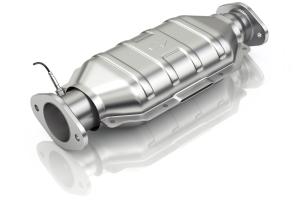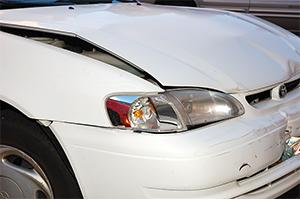Catalytic converter thefts increase as precious metal prices skyrocket

A catalytic converter is a device used to reduce fuel-burning vehicle emissions. It is affixed to the underside of a vehicle and has been mandatory on all U.S. vehicles since 1975.
Theft of catalytic converters has been a constant since their inception as they contain the precious metals palladium, platinum and rhodium. Thefts of catalytic converters have fluctuated for years along with the market values of these metals. In fact, according to the National Insurance Crime Bureau, in 2019, an average of 282 converters per month were stolen. That figure jumped to 1,203 per month the next year due to a sharp increase in the value of rhodium alone.
Catalytic converters can be easily removed with a socket wrench or battery-operated reciprocating saw in as little as 45 seconds; they can then be re-sold to metal recyclers. While all vehicles are at risk, SUVs, busses, vans and trucks are an easier target for catalytic converter thieves as their factory ground clearances are higher, allowing a thief to maneuver under the vehicle without having to use a jack. Vehicles parked close to each other present an opportunity for multiple catalytic converter thefts at one time.
The typical cost of replacement of a catalytic converter can range from $900 to $2,500 depending on the vehicle. This does not include the loss in revenue from downing one or more vehicles in your fleet, towing fees, etc.
What you can do to protect your investment and deter catalytic converter theft
- Whenever possible. park vehicles in a secured garage or building.
- Utilize fenced properties equipped with motion sensor lights, security cameras and signage indicating cameras are in use, help to deter thieves.
- Park vehicles in well-lit areas or areas that are more visible and have higher pedestrian traffic
- Space parked vehicles adequately apart to allow security lighting to properly illuminate the area.
- Install and calibrate vehicle security systems set to detect and alarm with contact or vibration.
- Avoid leaving vehicles parked for prolonged periods of time in the same spot.
- Equip your vehicles’ catalytic converters with physical theft deterrent systems, including caging and other affixed aftermarket components.
- Engrave your VIN and phone number into the converter to alert a scrap dealer it may be stolen and help identify you as the owner.
This material is provided for informational purposes only and does not provide any coverage or guarantee loss prevention. The examples in this material are provided as hypothetical and for illustration purposes only. The Hanover Insurance Company and its affiliates and subsidiaries (“The Hanover”) specifically disclaim any warranty or representation that acceptance of any recommendations contained herein will make any premises, or operation safe or in compliance with any law or regulation. By providing this information to you, The Hanover does not assume (and specifically disclaims) any duty, undertaking or responsibility to you. The decision to accept or implement any recommendation(s) or advice contained in this material must be made by you.
LC DEC 2018 08-47
171-1003 (5/2021)
Related resources
Catalytic converter thefts increase as precious metal prices skyrocket
A catalytic converter is a device used to reduce fuel-burning vehicle emissions. It is affixed to the underside of a vehicle and has been mandatory on all U.S. vehicles since 1975.
Theft of catalytic converters has been a constant since their inception as they contain the precious metals palladium, platinum and rhodium. Thefts of catalytic converters have fluctuated for years along with the market values of these metals. In fact, according to the National Insurance Crime Bureau, in 2019, an average of 282 converters per month were stolen. That figure jumped to 1,203 per month the next year due to a sharp increase in the value of rhodium alone.
Catalytic converters can be easily removed with a socket wrench or battery-operated reciprocating saw in as little as 45 seconds; they can then be re-sold to metal recyclers. While all vehicles are at risk, SUVs, busses, vans and trucks are an easier target for catalytic converter thieves as their factory ground clearances are higher, allowing a thief to maneuver under the vehicle without having to use a jack. Vehicles parked close to each other present an opportunity for multiple catalytic converter thefts at one time.
The typical cost of replacement of a catalytic converter can range from $900 to $2,500 depending on the vehicle. This does not include the loss in revenue from downing one or more vehicles in your fleet, towing fees, etc.
What you can do to protect your investment and deter catalytic converter theft
- Whenever possible. park vehicles in a secured garage or building.
- Utilize fenced properties equipped with motion sensor lights, security cameras and signage indicating cameras are in use, help to deter thieves.
- Park vehicles in well-lit areas or areas that are more visible and have higher pedestrian traffic
- Space parked vehicles adequately apart to allow security lighting to properly illuminate the area.
- Install and calibrate vehicle security systems set to detect and alarm with contact or vibration.
- Avoid leaving vehicles parked for prolonged periods of time in the same spot.
- Equip your vehicles’ catalytic converters with physical theft deterrent systems, including caging and other affixed aftermarket components.
- Engrave your VIN and phone number into the converter to alert a scrap dealer it may be stolen and help identify you as the owner.
This material is provided for informational purposes only and does not provide any coverage or guarantee loss prevention. The examples in this material are provided as hypothetical and for illustration purposes only. The Hanover Insurance Company and its affiliates and subsidiaries (“The Hanover”) specifically disclaim any warranty or representation that acceptance of any recommendations contained herein will make any premises, or operation safe or in compliance with any law or regulation. By providing this information to you, The Hanover does not assume (and specifically disclaims) any duty, undertaking or responsibility to you. The decision to accept or implement any recommendation(s) or advice contained in this material must be made by you.
LC DEC 2018 08-47
171-1003 (5/2021)
Related resources
Catalytic converter thefts increase as precious metal prices skyrocket
A catalytic converter is a device used to reduce fuel-burning vehicle emissions. It is affixed to the underside of a vehicle and has been mandatory on all U.S. vehicles since 1975.
Theft of catalytic converters has been a constant since their inception as they contain the precious metals palladium, platinum and rhodium. Thefts of catalytic converters have fluctuated for years along with the market values of these metals. In fact, according to the National Insurance Crime Bureau, in 2019, an average of 282 converters per month were stolen. That figure jumped to 1,203 per month the next year due to a sharp increase in the value of rhodium alone.
Catalytic converters can be easily removed with a socket wrench or battery-operated reciprocating saw in as little as 45 seconds; they can then be re-sold to metal recyclers. While all vehicles are at risk, SUVs, busses, vans and trucks are an easier target for catalytic converter thieves as their factory ground clearances are higher, allowing a thief to maneuver under the vehicle without having to use a jack. Vehicles parked close to each other present an opportunity for multiple catalytic converter thefts at one time.
The typical cost of replacement of a catalytic converter can range from $900 to $2,500 depending on the vehicle. This does not include the loss in revenue from downing one or more vehicles in your fleet, towing fees, etc.
What you can do to protect your investment and deter catalytic converter theft
- Whenever possible. park vehicles in a secured garage or building.
- Utilize fenced properties equipped with motion sensor lights, security cameras and signage indicating cameras are in use, help to deter thieves.
- Park vehicles in well-lit areas or areas that are more visible and have higher pedestrian traffic
- Space parked vehicles adequately apart to allow security lighting to properly illuminate the area.
- Install and calibrate vehicle security systems set to detect and alarm with contact or vibration.
- Avoid leaving vehicles parked for prolonged periods of time in the same spot.
- Equip your vehicles’ catalytic converters with physical theft deterrent systems, including caging and other affixed aftermarket components.
- Engrave your VIN and phone number into the converter to alert a scrap dealer it may be stolen and help identify you as the owner.
This material is provided for informational purposes only and does not provide any coverage or guarantee loss prevention. The examples in this material are provided as hypothetical and for illustration purposes only. The Hanover Insurance Company and its affiliates and subsidiaries (“The Hanover”) specifically disclaim any warranty or representation that acceptance of any recommendations contained herein will make any premises, or operation safe or in compliance with any law or regulation. By providing this information to you, The Hanover does not assume (and specifically disclaims) any duty, undertaking or responsibility to you. The decision to accept or implement any recommendation(s) or advice contained in this material must be made by you.
LC DEC 2018 08-47
171-1003 (5/2021)
Related resources
Catalytic converter thefts increase as precious metal prices skyrocket
A catalytic converter is a device used to reduce fuel-burning vehicle emissions. It is affixed to the underside of a vehicle and has been mandatory on all U.S. vehicles since 1975.
Theft of catalytic converters has been a constant since their inception as they contain the precious metals palladium, platinum and rhodium. Thefts of catalytic converters have fluctuated for years along with the market values of these metals. In fact, according to the National Insurance Crime Bureau, in 2019, an average of 282 converters per month were stolen. That figure jumped to 1,203 per month the next year due to a sharp increase in the value of rhodium alone.
Catalytic converters can be easily removed with a socket wrench or battery-operated reciprocating saw in as little as 45 seconds; they can then be re-sold to metal recyclers. While all vehicles are at risk, SUVs, busses, vans and trucks are an easier target for catalytic converter thieves as their factory ground clearances are higher, allowing a thief to maneuver under the vehicle without having to use a jack. Vehicles parked close to each other present an opportunity for multiple catalytic converter thefts at one time.
The typical cost of replacement of a catalytic converter can range from $900 to $2,500 depending on the vehicle. This does not include the loss in revenue from downing one or more vehicles in your fleet, towing fees, etc.
What you can do to protect your investment and deter catalytic converter theft
- Whenever possible. park vehicles in a secured garage or building.
- Utilize fenced properties equipped with motion sensor lights, security cameras and signage indicating cameras are in use, help to deter thieves.
- Park vehicles in well-lit areas or areas that are more visible and have higher pedestrian traffic
- Space parked vehicles adequately apart to allow security lighting to properly illuminate the area.
- Install and calibrate vehicle security systems set to detect and alarm with contact or vibration.
- Avoid leaving vehicles parked for prolonged periods of time in the same spot.
- Equip your vehicles’ catalytic converters with physical theft deterrent systems, including caging and other affixed aftermarket components.
- Engrave your VIN and phone number into the converter to alert a scrap dealer it may be stolen and help identify you as the owner.
This material is provided for informational purposes only and does not provide any coverage or guarantee loss prevention. The examples in this material are provided as hypothetical and for illustration purposes only. The Hanover Insurance Company and its affiliates and subsidiaries (“The Hanover”) specifically disclaim any warranty or representation that acceptance of any recommendations contained herein will make any premises, or operation safe or in compliance with any law or regulation. By providing this information to you, The Hanover does not assume (and specifically disclaims) any duty, undertaking or responsibility to you. The decision to accept or implement any recommendation(s) or advice contained in this material must be made by you.
LC DEC 2018 08-47
171-1003 (5/2021)





